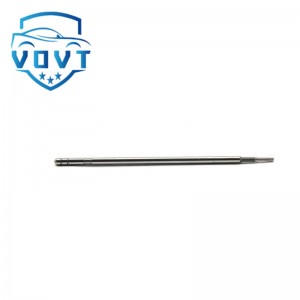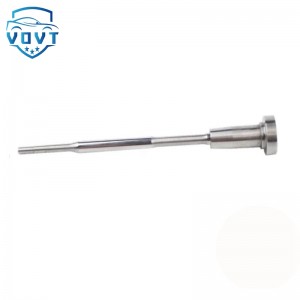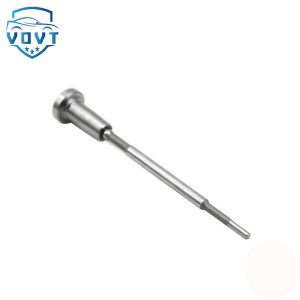High Precision New Diesel Injector Control Valve F00RJ03556 Valve Assembly for Fuel Injector Engine Spare Parts
Products Description
| Reference Codes | F00RJ03556 |
| Application | / |
| MOQ | 6 PCS |
| Certification | ISO9001 |
| Place of Origin | China |
| Packaging | Neutral packing |
| Quality Control | 100% tested before shipment |
| Lead time | 7~10 working days |
| Payment | T/T, L/C, Paypal, Western Union, MoneyGram or as your requirement |
The function of the injector valve assembly
Precisely control the injection time: match the engine working condition requirements
The valve assembly strictly controls the start and end time of fuel injection by responding to control signals (such as electrical signals or mechanical signals) to ensure synchronization with the engine piston movement, valve opening and closing and other working conditions.
Take the electromagnetic injector as an example: when the electromagnetic coil in the valve assembly is energized, it generates electromagnetic force to attract the armature, drive the valve core (needle valve) to rise, open the fuel channel, and start injecting fuel; after the coil is de-energized, the spring force pushes the valve core to reset and close the channel, and the injection ends. Its response time (about 0.1-0.3ms from power-on to the start of injection) directly determines the accuracy of the injection time. If it is delayed by 1ms, it may cause the combustion phase to shift and the engine power to drop by 2%-5%.
In the diesel engine high-pressure common rail system: the valve assembly needs to cooperate with the ECU (electronic control unit) command to open at a specific angle (such as 10°-20° crankshaft angle) before the top dead center of the compression stroke to ensure that the fuel ignites in time in high-temperature and high-pressure air to avoid early injection (knocking) or late injection (lack of power).
Precisely adjust the injection amount: adapt to changes in load and speed
The valve assembly controls the duration (or opening degree) of the valve core opening to accurately control the amount of fuel injected in a single injection to meet the needs of different engine operating conditions (such as idling, acceleration, and full load).
Principle mechanism: The longer the valve core is open (or the larger the opening degree), the more fuel flows through the valve seat channel. For example, the engine requires less fuel at idle speed (single cylinder single injection volume is about 2-5mm³), and the valve assembly opening time is only 0.5-1ms; when the engine is at full load, the amount of fuel required increases (single cylinder single injection volume is 15-30mm³), and the opening time is extended to 3-5ms.
Key design: The nozzle diameter of the valve seat (such as the nozzle diameter of the diesel engine injector is 0.15-0.3mm) and the valve core lift (0.1-0.3mm) directly affect the flow coefficient. The valve assembly needs to ensure the consistency of these parameters through precision machining (error ≤0.01mm), otherwise it will cause uneven injection of each cylinder and aggravate engine vibration.
Maintain high-pressure injection and atomization quality: improve combustion efficiency
The valve assembly needs to maintain sealing performance under the action of high-pressure fuel (diesel engines can reach 100-300MPa, gasoline engines 3-20MPa), and at the same time, the fuel atomization is enhanced through structural design to lay the foundation for efficient combustion.
High-pressure sealing effect: The matching clearance between the valve core and the valve seat is extremely small (usually ≤0.002mm), and it fits tightly under the action of the spring preload (10-30N) to prevent the high-pressure fuel from leaking in advance (the leakage amount must be ≤0.1mm³/time), otherwise it will cause the injection pressure to drop and fuel waste.
Atomization enhancement effect: After the valve core is opened, the high-pressure fuel is ejected at high speed through the valve seat spray hole (the flow rate can reach 200-400m/s), and is broken into fine oil droplets (diameter 10-50μm) at the outlet of the spray hole due to turbulence and air shear force. The number of nozzles (4-12 for diesel engines, 1-2 for gasoline engines), the shape of the nozzles (conical, cylindrical) and the angle (e.g. the nozzle angle of diesel engines is 120°-150°) of the valve assembly directly determine the atomization range and uniformity. The finer the oil droplets, the more fully they mix with the air, the combustion efficiency can be increased by 5%-10%, and the soot emission can be reduced by more than 30%.
Adapt to multi-condition injection strategy: optimize the combustion process
In order to reduce emissions (such as NOx, particulate matter) and fuel consumption, modern engines need to adopt multiple injection strategies (such as pre-injection, main injection, and post-injection). The valve assembly needs to support fast opening and closing and flexible adjustment to meet complex injection requirements.
Pre-injection: A small amount of injection (about 1-3mm³) is performed at a crankshaft angle of 10-20° before the main injection to preheat the combustion chamber, reduce the ignition delay during the main injection, and reduce the knock noise and NOx generation of the diesel engine. The valve assembly needs to complete the "open-close" action in a very short time (single cycle ≤ 0.5ms), which tests its response speed and stability.
Post-injection: A micro-injection (about 0.5-2mm³) is performed after the main injection to promote the oxidation of unburned hydrocarbons in the exhaust gas. In conjunction with the regeneration of the post-treatment system (such as the DPF particulate filter), the valve assembly needs to accurately control the injection amount to avoid excessive exhaust temperature.
Ensure system safety: prevent abnormal injection and damage
The valve assembly has a built-in protection mechanism to avoid engine damage under extreme working conditions (such as fuel overpressure and jamming):
Pressure limit protection: Some valve assemblies integrate a pressure relief valve, which automatically opens when the fuel pressure exceeds the set value (such as 350MPa for diesel engines) to release excessive pressure and prevent the injector or common rail pipe from bursting.
Anti-stuck design: The valve core and valve seat are made of wear-resistant materials (such as high-speed steel, ceramic coating), and fuel lubrication is used to reduce friction to avoid sticking due to impurities or carbon deposits (sticking will cause continuous fuel injection, causing engine knock or flameout).

























